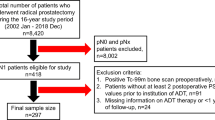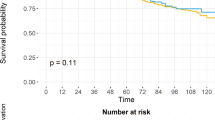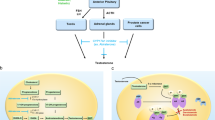Abstract
Introduction: Treatment options for lymph node positive prostate cancer are limited. We retrospectively compared patients who underwent external radiotherapy (ERT) to patients treated by radical prostatectomy (RPX).
Materials and Methods: A total of 102 lymph node positive patients from the RPX series at Ulm University were evaluated. In all, 76 patients received adjuvant androgen withdrawal as part of their primary treatment. In the ERT group, 44 patients were treated at the University of Michigan using a fractionated regimen. Of these, 21 patients received early adjuvant hormonal therapy. Patients with neoadjuvant therapy before RPX or ERT were excluded.
Results: In the RPX group, PSA nadir (nadir⩾0.2 vs >0.2 ng/ml) showed a strong association with outcome. In the ERT group, pretreatment PSA was an independent predictor of outcome (P=0.04) and patients with adjuvant hormonal therapy had a significant longer recurrence-free interval compared to patients without adjuvant therapy (P=0.004). Comparing only patients with adjuvant hormonal treatment after cancer-specific therapy, the ERT-treated patients had a borderline longer PSA recurrence-free survival time compared to the RPX-treated patients (P=0.05).
Conclusions: In case of positive lymph nodes, RPX and ERT might be considered and need to be explained to the patient. For future treatment decisions, the presented findings and a potential survival benefit need to be evaluated in a larger prospective setting.
This is a preview of subscription content, access via your institution
Access options
Subscribe to this journal
Receive 4 print issues and online access
$259.00 per year
only $64.75 per issue
Buy this article
- Purchase on SpringerLink
- Instant access to full article PDF
Prices may be subject to local taxes which are calculated during checkout



Similar content being viewed by others
References
Jemal A et al. Cancer statistics, 2002. CA Cancer J Clin 2002; 52: 23–47.
Holmberg L et al. A randomized trial comparing radical prostatectomy with watchful waiting in early prostate cancer. N Engl J Med 2002; 347: 781–789.
Davidson PJ et al. Progression in untreated carcinoma of the prostate metastatic to regional lymph nodes (stage t0 to 4,N1 to 3.M0,D1). European Organization for Research and Treatment of Cancer Genitourinary Group. J Urol 1995; 154: 2118–2122.
Seay TM, Blute ML, Zincke H . Long-term outcome in patients with pTxN+adenocarcinoma of prostate treated with radical prostatectomy and early androgen ablation. J Urol 1998; 159: 357–364.
Zwergel U et al. Lymph node positive prostate cancer: long-term survival data after radical prostatectomy. J Urol 2004; 171: 1128–1131.
Pollack A, Horwitz EM, Movsas B . Treatment of prostate cancer with regional lymph node (N1) metastasis. Semin Radiat Oncol 2003; 13: 121–129.
Fleming ID, Cancer AJCo, (U.S.) NCI. AJCC Cancer Staging Manual, 5th ed., Philadelphia: Lippincott-Raven, 1997.
Gleason DF . Classification of prostatic carcinomas. Cancer Chemother Rep 1966; 50: 125–128.
American Society for Therapeutic Radiology aOCP. Consensus Statement: Guidlines for PSA following radiation therapy. Int J Radiat Oncol Biol Phys 1997; 37: 1035–1041.
Choo R et al. Feasibility study: watchful waiting for localized low to intermediate grade prostate carcinoma with selective delayed intervention based on prostate specific antigen, histological and/or clinical progression. J Urol 2002; 167: 1664–1669.
Seay TM, Blute MC, Zincke H . Radical prostatectomy and early adjuvant hormonal therapy for pTxN+ adenocarcinoma of the prostate. Urology 1997; 50: 833–837.
Sandler HM et al. Three dimensional conformal radiotherapy for the treatment of prostate cancer: low risk of chronic rectal morbidity observed in a large series of patients. Int J Radiat Oncol Biol Phys 1995; 33: 797–801.
Fukunaga-Johnson N et al. Results of 3D conformal radiotherapy in the treatment of localized prostate cancer. Int J Radiat Oncol Biol Phys 1997; 38: 311–317.
Michalski JM et al. Preliminary report of toxicity following 3D radiation therapy for prostate cancer on 3DOG/RTOG 9406. Int J Radiat Oncol Biol Phys 2000; 46: 391–402.
Ryu JK et al. Interim report of toxicity from 3D conformal radiation therapy (3D-CRT) for prostate cancer on 3DOG/RTOG 9406, level III (79.2 gy). Int J Radiat Oncol Biol Phys 2002; 54: 1036–1046.
Jacob R et al. The relationship of increasing radiotherapy dose to reduced distant metastases and mortality in men with prostate cancer. Cancer 2004; 100: 538–543.
Asbell SO et al. Elective pelvic irradiation in stage A2, B carcinoma of the prostate: analysis of RTOG 77-06. Int J Radiat Oncol Biol Phys 1988; 15: 1307–1316.
Leibel SA et al. The effects of local and regional treatment on the metastatic outcome in prostatic carcinoma with pelvic lymph node involvement. Int J Radiat Oncol Biol Phys 1994; 28: 7–16.
Roach III M et al. Phase III trial comparing whole-pelvic vs prostate-only radiotherapy and neoadjuvant vs adjuvant combined androgen suppression: Radiation Therapy Oncology Group 9413. J Clin Oncol 2003; 21: 1904–1911.
Vaishampayan U, Hussain M . The evolving role of systemic therapy in high risk prostate cancer: strategies for cure in the 21st century. Crit Rev Oncol Hematol 2002; 42: 179–188.
Messing EM et al. Immediate hormonal therapy compared with observation after radical prostatectomy and pelvic lymphadenectomy in men with node-positive prostate cancer. N Engl J Med 1999; 341: 1781–1788.
Samson D-J et al. Systematic review and meta-analysis of monotherapy compared with combined androgen blockade for patients with advanced prostate carcinoma. Cancer 2002; 95: 361–376.
Ghavamian R et al. Radical retropubic prostatectomy plus orchiectomy vs orchiectomy alone for pTxN+prostate cancer: a matched comparison. J Urol 1999; 161: 1223–1227, discussion 1227–1228.
Heidenreich A, Varga Z, Von-Knobloch R . Extended pelvic lymphadenectomy in patients undergoing radical prostatectomy: high incidence of lymph node metastasis. J Urol 2002; 167: 1681–1686.
Wieder JA, Soloway MS . Incidence, etiology, location, prevention and treatment of positive surgical margins after radical prostatectomy for prostate cancer. J Urol 1998; 160: 299–315.
Gleave ME et al. Long-term neoadjuvant hormone therapy prior to radical prostatectomy: evaluation of risk for biochemical recurrence at 5-year follow-up. Urology 2000; 56: 289–294.
Bolla M et al. Improved survival in patients with locally advanced prostate cancer treated with radiotherapy and goserelin. N Engl J Med 1997; 337: 295–300.
Zincke H et al. Stage D1 prostate cancer treated by radical prostatectomy and adjuvant hormonal treatment. Evidence for favorable survival in patients with DNA diploid tumors. Cancer 1992; 70 (1 Suppl): 311–323.
Frohmuller HG et al. Survival and quality of life of patients with stage D1 (T1-3 pN1-2 M0) prostate cancer. Radical prostatectomy plus androgen deprivation vs androgen deprivation alone. Eur Urol 1995; 27: 202–206.
Zietman AL et al. The effect of androgen deprivation and radiation therapy on an androgen-sensitive murine tumor: an in vitro and in vivo study. Cancer J Sci Am 1997; 3: 31–36.
Pilepich MV et al. Phase III radiation therapy oncology group (RTOG) trial 86-10 of androgen deprivation adjuvant to definitive radiotherapy in locally advanced carcinoma of the prostate. Int J Radiat Oncol Biol Phys 2001; 50: 1243–1252.
Whittington R et al. The use of combined radiation therapy and hormonal therapy in the management of lymph node-positive prostate cancer. Int J Radiat Oncol Biol Phys 1997; 39: 673–680.
Sands ME, Pollack A, Zagars GK . Influence of radiotherapy on node-positive prostate cancer treated with androgen ablation. Int J Radiat Oncol Biol Phys 1995; 31: 13–19.
Zagars GK, Pollack A, von-Eschenbach AC . Addition of radiation therapy to androgen ablation improves outcome for subclinically node-positive prostate cancer. Urology 2001; 58: 233–239.
Zelefsky MJ et al. Significance of normal serum prostate-specific antigen in the follow-up period after definitive radiation therapy for prostatic cancer. J Clin Oncol 1995; 13: 459–463.
Cherullo EE et al. Variable definitions influence the reporting of biochemical failure rates. Prostate Cancer and Prostatic Disease 2002; 5: 54–58.
Taylor JM, Griffith KA, Sandler HM . Definitions of biochemical failure in prostate cancer following radiation therapy. Int J Radiat Oncol Biol Phys 2001; 50: 1212–1219.
Kalapurakal JA et al. Biochemical disease-free survival following adjuvant and salvage irradiation after radical prostatectomy. Int J Radiat Oncol Biol Phys 2002; 54: 1047–1054.
Acknowledgements
This study was supported by the Specialized Program of Research Excellence for Prostate Cancer (S.P.O.R.E.) NCI Grant no. P50CA69568.
Author information
Authors and Affiliations
Corresponding author
Rights and permissions
About this article
Cite this article
Kuefer, R., Volkmer, B., Loeffler, M. et al. Comparison of external radiation therapy vs radical prostatectomy in lymph node positive prostate cancer patients. Prostate Cancer Prostatic Dis 7, 343–349 (2004). https://doi.org/10.1038/sj.pcan.4500751
Received:
Revised:
Accepted:
Published:
Issue date:
DOI: https://doi.org/10.1038/sj.pcan.4500751



